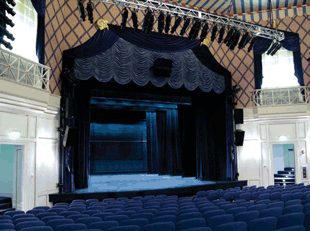Lights, Camera, Action

The Newly-Restored Guild Hall Regains Its Past Glory With The Future Of AV EAST HAMPTON, NY—Guild Hall in East Hampton, NY, built in 1931,
The theater’s new 25-foot Stewart Filmscreen 2.35:1 cinemascope screen is perfectly framed for widescreen film content and can be framed in for narrower content such as DVDs. houses a museum, community meeting space, and the John Drew Theater with its circus-style tented ceiling, glass ballooned chandelier, and diamond patterned walls. A recent renovation and facelift by Robert A.M. Stern Architects, Barbara Spandorf of theater consultants Fisher Dachs Associates, and JaffeHolden Acoustics has restored Guild Hall to its glory and led it into the 21st century of AV.
The $600,000 AV project by Jaffe- Holden principal acoustician Mark Holden and systems designer Ben Bausher was installed by AVI-SPL, New York. The renovation has provided the theater with a system that suits its function as a multi-purpose space for theater performance, music, and film, Bausher said. “I knew the architects wanted to take the theater back to its original 1930s interior design, and what I found when I first visited was an old AV system, cobbled together,” he said. “We needed to break it all down give them a cohesive design for what they want and need now.”
The theater’s EAW MK Series loudspeaker arrays are standard for a theater of this size, Bausher said. “We used two different speakers in each array; the 90 x 40s are aimed at the orchestra level and the 60 x 40s, narrower, aimed up and into balconies. Frontfills have grilles wrapped in black fabric and are recessed in front of the stage, and side surrounds, with white cloth, are in soffits between millwork and the fabric wall. The first eight feet up of the theater is millwork, so we needed to be careful to keep the sound from the arrays well controlled at the sidewalls.”

The choice was made to retain the theater’s 1960s Italian-made vintage Cinemecchanica 35MM projector. into the center of screen. In a pure theater, speakers are behind the screen, but here we a cheated a little by bringing left into right and right into left. Sonic imaging in a space this size is a big deal; you want it to sound like everything is coming from the stage.”
The theater’s new 25-foot Stewart Filmscreen 2.35:1 cinemascope screen is perfectly framed for widescreen film content and can be framed in for narrower content such as DVDs. The Digital Projection Lightning HD35 digital projector is “amazing,” Bausher said. “The film system has a dedicated audio path so they don’t have to bring it into the audio console with an engineer to run the board for film, as they had before. The operators can stream full cinemagrade digital projection from a D5 deck or a satellite broadcast from the Metropolitan Opera; it’s color calibrated to industry standards.”
The choice was made to retain the theater’s 1960s Italian-made vintage Cinemecchanica 35MM projector, as well as a Hortson 16mm model on which Bausher tried out the 2006 film Cars. “There we were, watching Cars with all its grit and grain—it reminded us how a different projection medium totally changes the character of the film,” he said. “The 35mm projector was retrofitted with a Dolby Digital Soundhead and decoder, giving it a new lease on life.”
A daily selection of the top stories for AV integrators, resellers and consultants. Sign up below.
A challenge for the integration team, led by Dean Motta, was the implementation of the conduit infrastructure within an historical building that was built in the 1930s. “JaffeHolden has stringent requirements on cable separation by signal type to ensure the highest possible audio/video quality standards,” noted Adrian Bennett, account executive, AVI-SPL, NY. The result is a one-of-a-kind facility.
